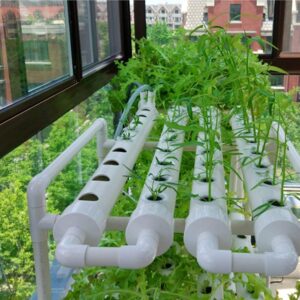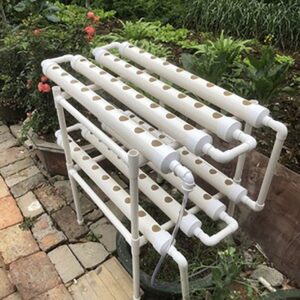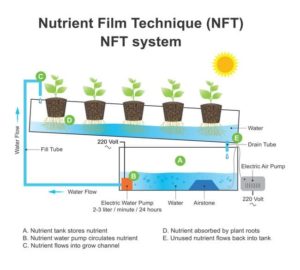Nutrient Film Technique Hydroponic System
Unveiling the Secrets of Nutrient Film Technique: Mastering Hydroponic Systems for Optimal Plant Growth

Are you looking to take your gardening skills to the next level? Look no further than the nutrient film technique (NFT) – a cutting-edge hydroponic system that promises optimal plant growth and a bountiful harvest.
In this article, we will unravel the secrets of the nutrient film technique, guiding you through the process of creating a thriving hydroponic garden. Hydroponics has gained immense popularity in recent years, and for good reason. By supplying plants with a nutrient-rich water solution, hydroponics eliminates the need for soil, offering numerous advantages such as increased crop yield, water conservation, and the ability to grow plants year-round. Among the various hydroponic systems, the nutrient film technique stands out for its simplicity and efficiency.
Through a thin film of nutrient solution constantly flowing over the roots, NFT provides plants with an ideal balance of water, oxygen, and essential nutrients, ensuring rapid and healthy growth. This article will delve into the specifics of setting up an NFT system, discuss the best plants to grow with this technique, and provide tips on troubleshooting common issues. Get ready to unlock the secrets of the nutrient film technique and embark on a journey towards thriving, hydroponic gardening.
Advantages of Using the Nutrient Film Technique
The Nutrient Film Technique (NFT) is a hydroponic method of growing plants without soil. It involves pumping a nutrient solution through a series of channels or tubes, where the roots of the plants are exposed to the thin film of water. The advantages of using the NFT are:
- It saves water and nutrients, as the excess solution is recirculated and reused.
- It allows for precise control of the pH and electrical conductivity of the solution, which affects the nutrient uptake and growth of the plants.
- It reduces the risk of pests and diseases, as there is no soil to harbor pathogens or insects.
- It increases the yield and quality of the crops, as the plants have constant access to oxygen and nutrients.
- It saves space and labour, as the plants can be grown in vertical or horizontal systems, and require less maintenance than soil-based systems.
How the Nutrient Film Technique Works
The nutrient film technique (NFT) is a hydroponic system that delivers a thin film of nutrient solution to the roots of plants. The solution flows through channels or tubes where the plants are suspended, and then recirculates back to a reservoir. The system does not use any growing medium, except for a small amount of material to support the seedlings.
The advantages of NFT include efficient use of water and nutrients, high yields, and easy maintenance. The disadvantages include vulnerability to power outages, clogging, and root diseases. To set up an NFT system, one needs to consider the following factors: channel size and slope, flow rate and volume, reservoir capacity and aeration, pH and electrical conductivity, and plant spacing and harvesting.
Setting up an NFT system – Equipment and Materials Needed
In an NFT system, nutrient-rich water is pumped through a series of channels or pipes, where the plant roots are suspended and constantly bathed in the solution. The excess water drains back into a reservoir and is recirculated. This way, the plants get all the water, oxygen and nutrients they need for optimal growth.
To set up an NFT system, you will need the following equipment and materials:
- A reservoir: This is where you store the nutrient solution that feeds your plants. It should be large enough to hold enough water for your system and have a lid to prevent evaporation and algae growth. You can use a plastic container, a metal tank or a wooden barrel as long as it is watertight and opaque.
- A pump: This is what moves the water from the reservoir to the channels. It should be powerful enough to deliver a steady flow of water to all your plants and have a filter to prevent clogging. You can use a submersible pump or an external pump depending on your preference and budget.
- Channels or pipes: These are where you place your plants and let the nutrient solution flow through. They should be slightly sloped to allow gravity to assist the water movement and have holes or slots to insert the plant pots or baskets. You can use PVC pipes, vinyl gutters or metal channels as long as they are durable and easy to clean.
- Plant pots or baskets: These are what hold your plants and their roots in the channels. They should be small enough to fit in the holes or slots and have holes or slits to allow the roots to hang out. You can use plastic pots, net pots or mesh baskets as long as they are lightweight and breathable.
- Growing medium: This is what supports your plants and their roots in the pots or baskets. It should be inert, sterile and well-drained to prevent root rot and disease. You can use rockwool, perlite, clay pebbles or coco coir as long as they are suitable for hydroponics.
- Nutrient solution: This is what feeds your plants and provides them with all the essential elements they need for growth. It should be balanced, complete and pH-adjusted to suit your plants’ needs. You can use ready-made hydroponic nutrients or make your own from organic or synthetic fertilizers as long as you follow the instructions and measure accurately.
- pH and EC meters: These are what monitor the acidity and concentration of your nutrient solution. They should be accurate, reliable and easy to use. You can use digital or analog meters as long as you calibrate them regularly and replace the batteries or electrodes when needed.
- Air pump and air stone: These are what aerate your nutrient solution and provide oxygen to your plant roots. They should be powerful enough to create bubbles and turbulence in the reservoir and have a diffuser to distribute the air evenly. You can use any aquarium air pump and air stone as long as they are compatible with your reservoir size and pump capacity.
Choosing the Right Plants for NFT

NFT stands for Nutrient Film Technique, a hydroponic system that uses a thin film of nutrient solution to feed the plants. NFT is suitable for growing a variety of crops, but some plants are more compatible with this method than others. In this article, we will discuss some factors to consider when choosing the right plants for NFT, and some examples of crops that thrive in this system.
One of the main factors to consider is the size and shape of the plants. NFT works best for plants that have a small root system and a compact growth habit. Plants that grow too large or too tall may interfere with the flow of the nutrient solution, or block the light and air circulation for other plants. Additionally, plants that have a sprawling or vining habit may not fit well in the narrow channels of NFT systems.
Another factor to consider is the nutrient and water requirements of the plants. NFT provides a constant supply of water and nutrients to the roots, which can be beneficial for plants that have high demands. However, some plants may prefer a drier or less fertile environment, and may suffer from overwatering or nutrient burn in NFT systems. Therefore, it is important to choose plants that have similar needs and preferences, and adjust the nutrient solution accordingly.
Some examples of plants that are well suited for NFT systems are leafy greens, herbs, strawberries, lettuce, spinach, kale, basil, mint, chives, and cilantro. These plants have a small root system, a compact growth habit, and a high demand for water and nutrients. They also mature quickly and can be harvested frequently, making them ideal for NFT systems.
Some examples of plants that are not recommended for NFT systems are root crops, fruiting crops, woody plants, and ornamental plants. These plants have a large root system, a tall or sprawling growth habit, and a lower demand for water and nutrients. They also take longer to mature and require more space and support, making them unsuitable for NFT systems.
Nutrient Solutions for NFT
NFT stands for Nutrient Film Technique, a hydroponic system that delivers a thin film of nutrient solution to the roots of plants. The nutrient solution is constantly recirculated, ensuring that the plants receive adequate water, oxygen and nutrients. NFT is suitable for growing leafy greens, herbs, strawberries and other crops that have a shallow root system.
The quality of the nutrient solution is crucial for the success of NFT. The nutrient solution should have the right balance of macronutrients (nitrogen, phosphorus, potassium, calcium, magnesium and sulphur) and micronutrients (iron, manganese, zinc, copper, boron, molybdenum and chlorine) for the specific crop. The nutrient solution should also have the appropriate pH and electrical conductivity (EC) levels to facilitate nutrient uptake and prevent nutrient lockout or toxicity.
The pH of the nutrient solution should be maintained between 5.5 and 6.5 for most crops. The pH can be adjusted by adding acid or base solutions to the reservoir. The EC of the nutrient solution should be monitored regularly and adjusted according to the crop stage and environmental conditions. The EC can be increased by adding more nutrients or decreased by adding more water to the reservoir. The EC range for most crops is between 1.0 and 2.5 mS/cm.
The nutrient solution should be changed every two to four weeks to prevent nutrient depletion or accumulation. The reservoir should also be cleaned and sanitized regularly to prevent algae growth and microbial contamination. The nutrient solution temperature should be kept between 18 and 24°C to optimize oxygen solubility and root health.
NFT is a simple and efficient hydroponic system that can produce high-quality crops with minimal water and fertilizer inputs. However, it requires careful management of the nutrient solution to ensure optimal plant growth and yield.
Maintaining an NFT System – pH Levels, Nutrient Balance, and Water Temperature
An NFT system, or nutrient film technique, is a type of hydroponic system that uses a thin film of nutrient solution to feed the plants. The nutrient solution is constantly recirculated through the system, providing the plants with water, oxygen, and minerals. However, to ensure optimal plant growth and health, it is important to monitor and adjust some key parameters of the nutrient solution, such as pH levels, nutrient balance, and water temperature.
pH levels measure the acidity or alkalinity of the nutrient solution. The ideal pH range for most plants is between 5.5 and 6.5. If the pH is too high or too low, it can affect the availability and uptake of certain nutrients by the plants, leading to deficiencies or toxicities. To measure the pH of the nutrient solution, you can use a pH meter or a pH test kit. To adjust the pH, you can use pH up or pH down solutions, which are usually made of acids or bases. You should always add small amounts of these solutions and test the pH again until you reach the desired level.
Nutrient balance refers to the ratio and concentration of the essential elements that plants need for growth and development. These elements are divided into two categories: macronutrients and micronutrients. Macronutrients are needed in larger amounts and include nitrogen, phosphorus, potassium, calcium, magnesium, and sulphur. Micronutrients are needed in smaller amounts and include iron, manganese, zinc, copper, boron, molybdenum, and chlorine.
The nutrient balance of the solution depends on the type and stage of the plants you are growing, as well as the quality of the water you are using. To measure the nutrient balance of the solution, you can use an EC meter or a TDS meter, which indicate the electrical conductivity or total dissolved solids of the solution. To adjust the nutrient balance, you can use premixed hydroponic nutrients that are formulated for different crops and stages, or you can mix your own nutrients from individual salts or organic sources. You should always follow the instructions on the label or recipe and test the EC or TDS again until you reach the desired level.
Water temperature affects the dissolved oxygen content and the metabolic rate of the plants. The ideal water temperature for most plants is between 18°C and 24°C. If the water temperature is too high or too low, it can reduce the oxygen availability and uptake by the plants, leading to stress or disease. To measure the water temperature of the nutrient solution, you can use a thermometer or a temperature sensor. To adjust the water temperature, you can use a water heater or a water chiller, which are devices that regulate the temperature of the solution. You should always set these devices to maintain a stable and consistent temperature within the optimal range.
Conclusion – Why the Nutrient Film Technique is a Game-Changer in Hydroponic Gardening.

The nutrient film technique (NFT) is a hydroponic system that delivers a thin film of nutrient solution to the roots of plants, allowing them to absorb water and minerals efficiently. NFT has several advantages over other hydroponic methods, such as reduced water and nutrient consumption, increased yield and quality, easier maintenance and pest control, and lower environmental impact.
NFT is a game-changer in hydroponic gardening because it offers a simple, cost-effective, and sustainable way to grow crops in any space and climate. NFT can be used to produce a variety of plants, from leafy greens and herbs to fruits and flowers, with minimal inputs and maximum outputs. NFT is not only a viable option for commercial growers, but also for hobbyists, educators, and urban farmers who want to enjoy the benefits of hydroponic gardening without the hassle. NFT is the future of hydroponic gardening, and anyone can get started with this innovative technique with some basic equipment and knowledge.
